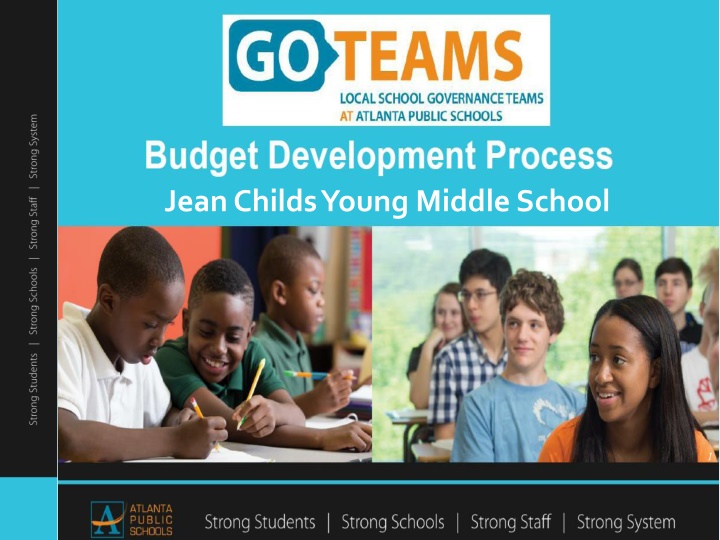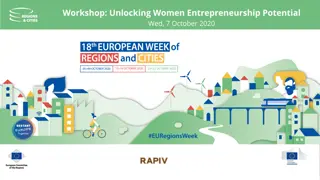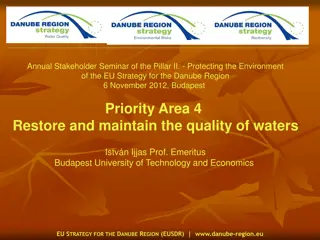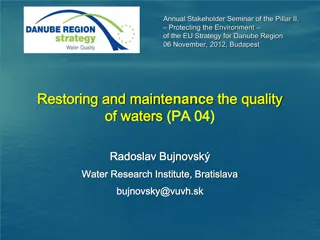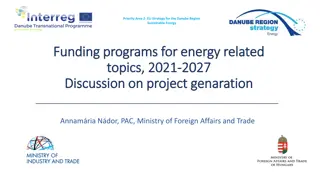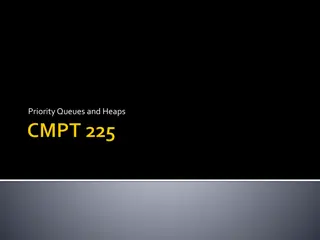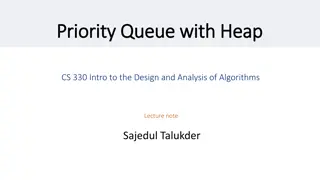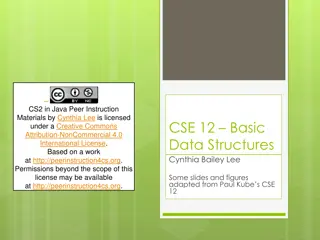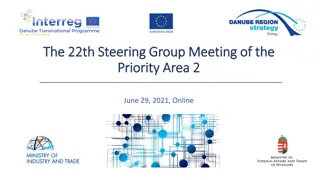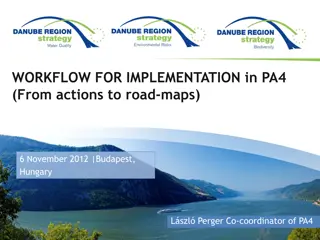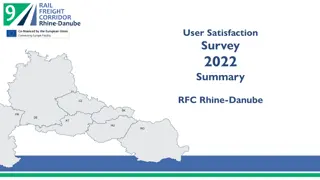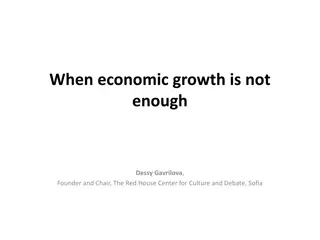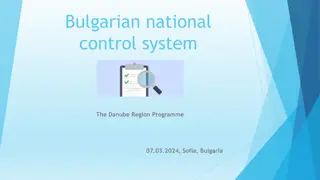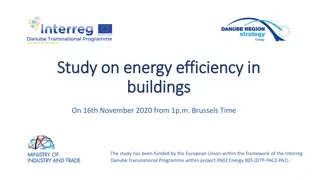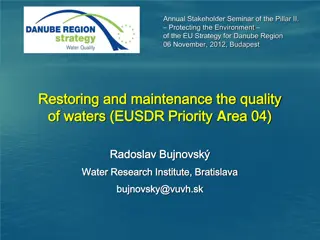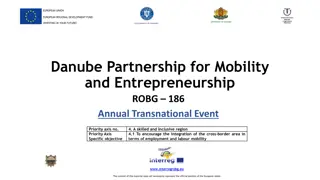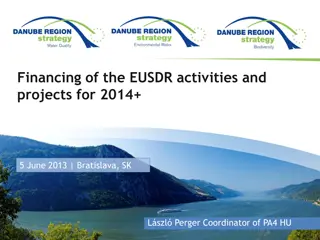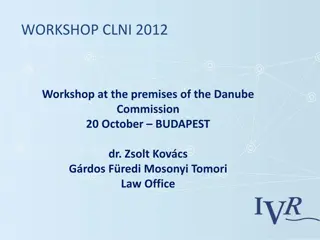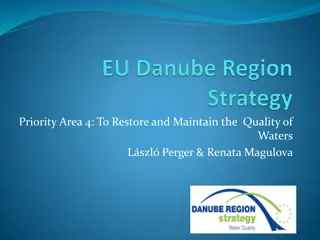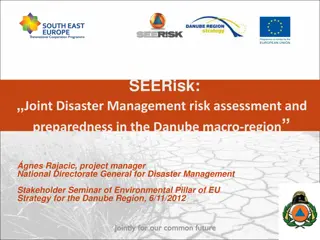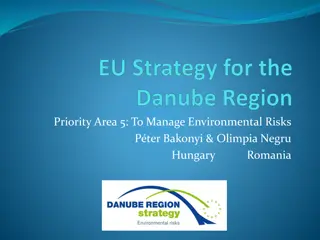EU Strategy for the Danube Region - Priority Area 8 Clusters Excellence
Priority Area 8 aims to support the competitiveness of enterprises through cluster development. Working groups focus on innovation, technology transfer, clusters excellence, vocational training, competitiveness in rural and urban areas, and entrepreneurial learning. The 1st Cluster Workshop discussed financial frameworks and the need for institutional support in cluster development within the EUSDR.
Download Presentation

Please find below an Image/Link to download the presentation.
The content on the website is provided AS IS for your information and personal use only. It may not be sold, licensed, or shared on other websites without obtaining consent from the author.If you encounter any issues during the download, it is possible that the publisher has removed the file from their server.
You are allowed to download the files provided on this website for personal or commercial use, subject to the condition that they are used lawfully. All files are the property of their respective owners.
The content on the website is provided AS IS for your information and personal use only. It may not be sold, licensed, or shared on other websites without obtaining consent from the author.
E N D
Presentation Transcript
GO Team Budget Development Process YOUR SCHOOL STRATEGIC PLAN is your roadmap and your role. It is your direction, your priorities, your vision, your present, your future. Step 1: Data Review Step 2: Strategic Plan Review Step 3: Budget Parameters Step 4: Budget Choices
FY20 Budget Development Process Principal s Role Design the budget and propose operational changes that can raise student achievement Flesh out strategies, implement and manage them at the school level Focus on the day-to-day operations Serve as the expert on the school Hire quality instructional and support personnel The GO Team s Role: Focus on the big picture (positions and resources, not people) Ensure that the budget is aligned to the school s mission and vision and that resources are allocated to support key strategic priorities 3
FY20 Priorities & SMART Goals (From your Strategic Plan, insert your Top 2 Priorities & SMART Goals for FY20 here) School Priorities SMART Goals 1. Fill all vacancies for FY 20 by May 2019 with teachers who have evidence of implementing effective Tier 1 instruction as evidenced through student learning data. Recruit, hire, and retain an effective teacher in every classroom. 1. Support teacher effectiveness by providing more direct behavioral, intervention, and instructional support by reducing the ratio of support personnel: teacher. Build and implement systems for identifying and addressing root causes which may prohibit academic growth for all students 1. Reduce the caseloads of support personnel so that more direct support is provided to teachers and students. 1. Provide training to all support personnel on effective behavior and academic interventions. 5 2. Streamline and reorganize support services so that direct support is timely, supportive, and monitored.
Discussion of Budget Summary (Step 4: Budget Choices) 6
Executive Summary This budget represents an investment plan for our school s students, employees and the community as a whole. The budget recommendations are tied directly to the school s strategic vision and direction. The proposed budget for the general operations of the school are reflected at $8,815,813. This investment plan for FY20 accommodates a student population that is projected to be 810 students, which is a increase/decrease of 63 projected students from FY19. 7
Allocation Summary FY2020 TOTAL SCHOOL ALLOCATIONS BUDGET IMPACTS School Location Level FY2020 Projected Enrollment Change in Enrollment from FY2019 Total Earned Young Middle School 0282 MS 810 Title I SSF Formula Leveling Hold Harmless Turnaround $ $ $ $ (50,204) (104,816) (50,204) 121,793 -63 Change in Enrollment -63 $ 8,815,813 8
School Allocation SSF Category Base Per Pupil Grade Level Kindergarten 1st 2nd 3rd 4th 5th 6th 9th Poverty EIP/REP Special Education Gifted Gifted Supplement ELL Small School Supplement Incoming Performance Baseline Supplement Transition Policy Supplement Count 810 Weight $4,420 Allocation $ 3,579,964 0 0 0 0 0 0 0.65 0.30 0.30 0.30 0.10 0.10 0.05 0.00 0.50 1.05 0.03 0.60 0.60 0.15 0.40 0.10 $ $ $ $ $ $ $ $ $ $ $ $ $ $ $ $ $ $ - - - - - - 300 0 540 22 148 42 0 28 FALSE 148 No No 66,296 - 1,193,321 102,095 19,624 111,377 - 18,563 - 182,092 9 - -
School Allocation Additional Earnings Signature Turnaround Title I School Improvement Field Trip Transportation Dual Campus Supplement District Funded Stipends $ $ $ $ $ $ $ 137,000 684,261 478,800 70,000 21,308 - 45,003 Total FTE Allotments 27.50 $ 2,106,110 10
Whats Next? January: GO Team Initial Budget Session (Jan. 22nd-31st) February: One-on-one Associate Superintendent discussions Cluster Planning Session (positions sharing, cluster alignment, etc.) Program Manager discussions and approvals GO Team Feedback Session HR Staffing Conferences (February 25th - March 1st) March: Final GO Team Approval (March 1st - March 15th) 11
FY20 Priorities & SMART Goals (From your Strategic Plan, insert your Top 2 Priorities & SMART Goals for FY20 here) School Priorities SMART Goals 1. Fill all vacancies for FY 20 by May 2019 with teachers who have evidence of implementing effective Tier 1 instruction as evidenced through student learning data. Recruit, hire, and retain an effective teacher in every classroom. 1. Support teacher effectiveness by providing more direct behavioral, intervention, and instructional support by reducing the ratio of support personnel: teacher. Build and implement systems for identifying and addressing root causes which may prohibit academic growth for all students 1. Reduce the caseloads of support personnel so that more direct support is provided to teachers and students. 1. Provide training to all support personnel on effective behavior and academic interventions. 12 2. Streamline and reorganize support services so that direct support is timely, supportive, and monitored.
Key Proposals in FY 2020 budget allocations -Keep number of classes per grade the same BUT (move to 2-person teams on 6th/7th to provide more support to students) -Keep number of Connections courses offered the same (bring back CTAE: Engineering/STEAM)
Key Proposals in FY 2020 budget allocations: Positions -Add New Targeted Support Positions Engagement Specialist (Student, Staff, Parents, Community) Full time Turnaround Social Worker BCBA and Behavior Technician 6 Master Teacher Leaders (2 per grade level) Hands on Atlanta tutors
Key Proposals in FY 2020 budget allocations: Curriculum -Add a viable, researched-based, rigorous and relevant ELA curriculum with teacher training and support Wit and Wisdom -Fund Reading materials for Advisory Reading block -Funds hands on Science kits -Fund requested academic subscriptions
Key Proposals in FY 2020 budget allocations: Talent Development -Fund IB development via dues and training -Fund RELAY training and support
Key Proposals in FY 2020 budget allocations: Other -Fund enhancement to technology (updated boards in classrooms) -Fund Student Engagement via sponsor stipends Debate, Robotics, Yearbook, Chess, Student Council, NJHS, Beta Club
Questions to Consider 1. Are our school s priorities (from your strategic plan) reflected in this budget? a. Are new positions and/or resources included in the budget to address our major priorities? b. Do we know (as a team) the plan to support implementation of these priorities beyond the budget (ex. What strategies will be implemented)? c. What tradeoffs are being made in order to support these priorities? 2. How are district and cluster priorities reflected in our budget? a. Cluster priorities- what staff, materials, etc. are dedicated to supporting our cluster s priorities? b. Signature programs- what staff, materials, etc. are dedicated to supporting our signature program? c. Are there positions our school will share with another school, i.e. nurse, counselor? 18
